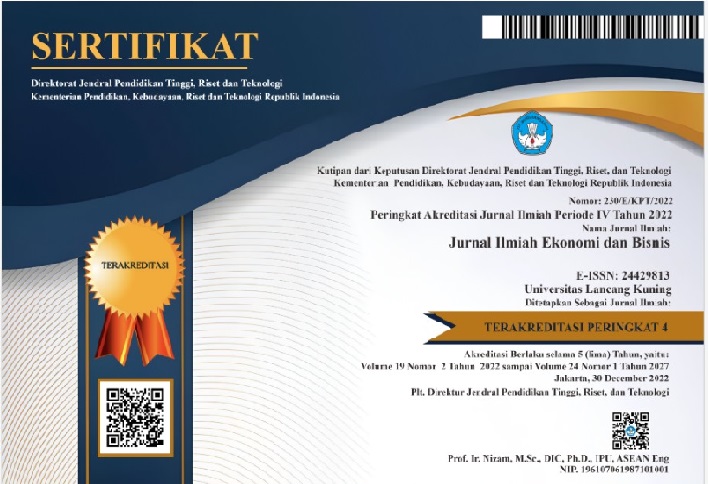A GOVERNMENT ROLE THROUGH ICT FOR ECONOMIC GROWTH
DOI:
https://doi.org/10.31849/jieb.v19i2.10751Keywords:
ICT development, Digital Divide, Bridging Digital Divide, Economic Growth, Role of Government, Ease of doing business, Social safety net protection.Abstract
- The economic growth processes and their acceleration have become essential factors in solving social and economic problems. Innovation-driven Information and Communication Technology (ICT) is believed to be the driver of economic growth. However, ICT raises the digital divide problem, which weakens the influence of ICT on economic growth. This study aims to develop a model that can explain the role of government as a factor that strengthens the influence of ICT on economic growth. The model is formulated using data from 114 countries listed in the Network Readiness Index (NRI) 2019. The study results prove that the digital divide is a factor that weakens the influence of ICT on economic growth and the role of government as a factor that strengthens the influence of ICT development on economic growth. This study recommends that innovations for ICT development provide options for countries that find it challenging to invest in ICT development, especially for 4.0 or 5.0 technological innovations. Nevertheless, human resource development is used to realize innovations in ICT development.
References
Afonasova, M. A., Panfilova, E. E., Galichkina, M. A., & Ślusarczyk, B. (2019). Digitalization in Economy and Innovation : The Effect on Social and Economic Processes DIGITALIZATION IN ECONOMY AND INNOVATION : THE, (August). https://doi.org/10.17512/pjms.2019.19.2.02
Avgerou, C. (2003). IT as an institutional actor in developing countries. The Digital Challenge: Information Technology in the Development Context, (January 2004), 46–62.
Ayanso, A., Cho, D. I., and Lertwachara, K. (2014). Information and Communications Technology Development and the Digital Divide: A Global and Regional Assessment. Information Technology for Development, 20(1), 60–77. https://doi.org/10.1080/02681102.2013.797378
Banelienė, R., & Melnikas, B. (2020). Economic growth and investment in R&D: Contemporary challenges for the european union. Contemporary Economics, 14(1), 38–57. https://doi.org/10.5709/ce.1897-9254.331
Berisha-shaqiri, A. (2015). Information Technology and the Digital Economy, (November). https://doi.org/10.5901/mjss.2015.v6n6p78
Burri, M. (2011). Re-conceptualizing the Global Digital Divide.
Buschmaas Julian , Calvin Chan, Leoni Mendler, Catherine Qi, and H. (2019). Measuring the Digital Divide in the Asia-Pacific Region for the United Nations Economic and Social Commission for Asia and the Pacific (ESCAP)o Title. Bangkok, Thailand.
Chinn, M. D., and Fairlie, R. W. (2007). The determinants of the global digital divide: A cross-country analysis of computer and internet penetration. Oxford Economic Papers, 59(1), 16–44. https://doi.org/10.1093/oep/gpl024
Fakt, T. (2020). Total Factor Productivity Growth and Demograhpics: The Case of Turkey. Journal of Research in Economics, Politics & Finance, 5(1), 81–90. https://doi.org/10.30784/epfad.
Gano-An, J. C., and Chooi Chea, C. (2021). Ease of Doing Business in the Philippines and Malaysia: Prospects for Development and Regional Growth. American Journal of Business and Society, 6(2), 49–56. Retrieved from http://www.aiscience.org/journal/ajbs
Gault, F. (2019). User innovation in the digital economy. Foresight and STI Governance, 13(3), 6–12. https://doi.org/10.17323/2500-2597.2019.3.6.12
Genus, A., and Nor, M. A. M. (2007). Bridging the digital divide in Malaysia: An empirical analysis of technological transformation and implications for e-development. Asia Pacific Business Review, 13(1), 95–112. https://doi.org/10.1080/13602380601010573
Guo, S., Ding, W., and Lanshina, T. (2017). Global Governance and the Role of the G20 in the Emerging Digital Economy. International Organisations Research Journal, 12(4), 169–184. https://doi.org/10.17323/1996-7845-2017-04-169
Ja’afar, R. (2020). Demographic Transition and Economic Potential:Malaysia. SCMS Journal of Indian Management, XVII(3), 26–35.
Janaćković, M., and Petrović-Ranđelović, M. (2019). Relationship Between Ease of Doing Business Indicators and the Foreign Direct Investment Inflows in the Republic of Serbia. Facta Universitatis, Series: Economics and Organization, 16, 269. https://doi.org/10.22190/fueo1903269j
Kaba, A., and Said, R. (2015). Bridging the digital divide through ICT : A comparative study of countries of the Gulf Cooperation Council , ASEAN and other Arab countries. Information Development, 30(4), 358–365. https://doi.org/10.1177/0266666913489987
Kiatsuranon, K., and Suwunnamek, O. (2019). Determinants of Thai information and communication technology organization performance: A structural equation model analysis. Kasetsart Journal of Social Sciences, 40(1), 113–120. https://doi.org/10.1016/j.kjss.2017.08.004
Luna-Reyes, L. F., and Gil-Garcia, J. R. (2011). Using institutional theory and dynamic simulation to understand complex e-Government phenomena. Government Information Quarterly, 28(3), 329–345. https://doi.org/10.1016/j.giq.2010.08.007
Mansell, R. (2001). Digital opportunities and the missing link for developing countries. https://doi.org/10.1093/oxrep/17.2.282
Mardikyan, S., Yıldız, E., Ordu, M., & Şimşek, B. (2015). Examining the Global Digital Divide: A Cross-Country Analysis. Communications of the IBIMA, (January), 1–10. https://doi.org/10.5171/2015.592253
Mistry, J. J. (2014). Journal of Global Information A Conceptual Framework for the Role of Government in Bridging the Digital Divide. Journal of Global Information Technology Management, 8(3), 28–46. https://doi.org/10.1080/1097198X.2005.10856401
Nasab, E. H., and Aghaei, M. (2009). The Effect of ICT on Economic Growth: Further Evidence, (5), 46–56.
Niebel, T. (2017). ICT and economic growth – Comparing developing , emerging and developed countries. World Development, 104, 197–211. https://doi.org/10.1016/j.worlddev.2017.11.024
Nieminen, H. (2016). Digital divide and beyond: What do we know of Information and Communications Technology’s long-term social effects? Some uncomfortable questions. European Journal of Communication, 31(1), 19–32. https://doi.org/10.1177/0267323115614198
Nipo, D. T., Bujang, I., and King, T. S. (2014). Global digital divide: determinants of cross-country ICT development with special reference to Southeast Asia. International Journal of Business & Economic Development, 2(3), 83–95. Retrieved from http://search.ebscohost.com.ezproxy.liv.ac.uk/login.aspx?direct=true&db=bth&AN=100271403&site=eds-live&scope=site
Nyman-Metcalf, K., and Papageorgiou, I. F. (2018). The European Union Digital Single Market - Challenges and Impact for the EU Neighbourhood States. Baltic Journal of European Studies, 8(2), 7–23. https://doi.org/10.1515/bjes-2018-0013
OECD. (2001). Understanding the digital divide. Understanding the Digital Divide (Vol. 2). https://doi.org/10.1787/236405667766
OECD Southeast Asia Regional Forum. (2017). Opportunities and Policy Challenges of Digitalisation in Southeast Asia. Oecd, (August), 26. Retrieved from https://www.oecd.org/southeast-asia/events/regional-forum/Forum_Note_Digital_Transformation_STI.pdf
Park, H. J., & Choi, S. O. 2019. Digital innovation adoption and its economic impact focused on path analysis at national level. Journal of Open Innovation: Technology, Market, and Complexity, 5(3). https://doi.org/10.3390/joitmc5030056
Patel, L. 2018. Social protection in africa: Beyond safety nets? Journal of Sociology and Social Welfare, 45(4), 79–103.
Ragnedda, M. (2020). 2 . Conceptualising the digital divide, (April). https://doi.org/10.1515/9789048538225-004
Riggins, F., and Dewan, S. (2005). The Digital Divide: Current and Future Research Directions. Journal of the Association for Information Systems, 6(12), 298–337. https://doi.org/10.17705/1jais.00074
Rostiana, E., and Rodesbi, A. (2020). Transisi Demografi dan Pertumbuhan Ekonomi Indonesia. Jurnal Economia, 16(1), 1–17. https://doi.org/10.21831/economia.v16i1.29846
Samad, S. A. (2019). Empowering Social Protection System . The Role of Government and a Way Forward. Journal of Administrative Science, 16(2), 27–41.
Song, Z., Song, T., Yang, Y., and Wang, Z. (2019). Spatial-temporal characteristics and determinants of digital divide in China: A multivariate spatial analysis. Sustainability (Switzerland), 11(17), 13–15. https://doi.org/10.3390/su11174529
Srinuan, C., Srinuan, P., & Bohlin, E. (2012). An analysis of mobile Internet access in Thailand: Implications for bridging the digital divide. Telematics and Informatics, 29(3), 254–262. https://doi.org/10.1016/j.tele.2011.10.003
Szeles, M. R., and Simionescu, M. (2020). Regional Patterns and Drivers of the EU Digital Economy. Social Indicators Research, (0123456789). https://doi.org/10.1007/s11205-020-02287-x
Toader, E., Firtescu, B. N., and Roman, A. (2018). Impact of Information and Communication Technology Infrastructure on Economic Growth : An Empirical Assessment for the EU Countries, 1–22. https://doi.org/10.3390/su10103750
Tsaura, M. A., and Felayati, R. A. (2016). Digital Divide in ASEAN : Analyzing Regional Integration through Information and Communication Technologies Development.
UNCTAD. (2019). Digital Economy Report 2019: Value Creation And Capture Implication For Developing Countries. New York.
Wolfram, M. (2012). Deconstructing smart cities: An intertextual reaing of concepts and practices for integrated urban and ICT development. Real Corp 2012, 0(May), 171–181. Retrieved from http://www.corp.at/archive/CORP2012_192.pdf
Wong, Y. C., Law, C. K., Chu Fung, J. Y., and Ping Lee, V. W. (2010). Digital divide and social inclusion: Policy challenge for social development in Hong Kong and south Korea. Journal of Asian Public Policy, 3(1), 37–52. https://doi.org/10.1080/17516231003634161
World Bank, G. (2020). Doing Business 2020. World Bank Publications (Vol. 6). https://doi.org/10.7256/1812-8688.2014.6.12196
Ye, L., and Yang, H. (2020). From Digital Divide to Social Inclusion : A Tale of Mobile Platform Empowerment in Rural Areas.
Yu, B., Ndumu, A., Mon, L. M., and Fan, Z. (2018). E-inclusion or digital divide : an integrated model of digital inequality Article information :, (February). https://doi.org/10.1108/JD-10-2017-0148
Zhang, B., Jin, Z., and Peng, Z. (2018). Bridging the Digital Divide: Making the Digital Economy Benefit to the Entire Society (pp. 1–31). Seoul, Korea: International Telecommunications Society (ITS). Retrieved from http://hdl.handle.net/10419/190412
Zheng, Y. (2015). ICT4D , Overview of Theories in . The International Encyclopedia of Digital Communication and Society, (May), 1–10. https://doi.org/10.1002/9781118767771.wbiedcs153












 This work is licensed under a Attribution 4.0 International (CC BY 4.0)
This work is licensed under a Attribution 4.0 International (CC BY 4.0) 